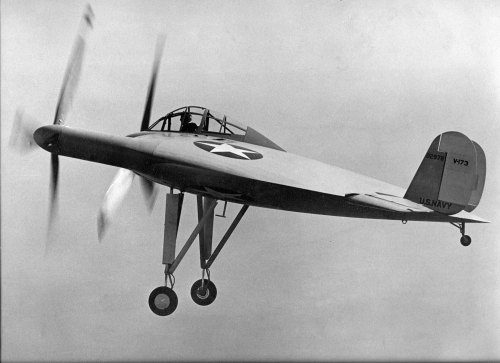The Vought V-173 and the XF5U-1 “Flying Flapjack”,In the 1930’s Charles Zimmerman
The Vought V-173 and the XF5U-1 “Flying Flapjack”,In the 1930’s Charles Zimmerman was an aeronautical engineer with a very unorthodox idea. As anyone who knows anything about fluid dynamics can attest, drag is often the killer of speed. When it comes to aircraft the tips of the wings often create the most drag as it flies through the air. Zimmerman sought to build a “low aspect” aircraft that created as little drag as possible. His strange design, called the Vought V-173 (top 3 pictures), didn’t have normal wings like a traditional airplane. Rather the aircraft was saucer shaped, with the entire body of the airplane acting as a wing. The craft was also driven by two engines working two propellers. The propellers rotated opposite of each other, creating a vortex under the wing, supplying it lift. What result was a “flying wing” with incredibly efficient aerodynamics and lift capabilities.The brilliant new design made its first test flight in 1942. It was then that the US Navy became interested in Zimmerman’s work. At the time, the military was in great need of a revolutionary fighter design to help fight World War II. The V-173 was only a prototype created to demonstrate proof of concept. With the help of Naval engineers, Zimmerman improved and added to the V-173 design. A strengthened, more stable frame was added as well as a stronger reinforced cockpit. Essentially everything made made stronger and heavily armored. Two Pratt and Whitney R-2000-7 engines were installed, each of which produced 1,350 horsepower. Retractable landing gear was also added. Finally there were the weapons; 6 .50 caliber machine guns or 4 20mm cannon. In addition the new fighter could carry 2 one thousand pound bombs, or rocket pods.Called the XF5U-1 “Flying Flapjack” (bottom 3 pictures), the new fighter exceeded all expectations. However the new design had several kinks that needed to worked out, which delayed it’s introduction. Unfortunately, the Vought XF5U-1 program was not completed by the end of World War II. If the new fighter had been introduced and mass produced, it would have certainly been the deadliest fighter of the war. With a top speed of 550 mph, it was almost as fast as the deadly German Me-262 jet fighter. However, it was much more maneuverable, had thicker armor, carried more weapons, and with a range of 1,046 miles it could fly significantly farther than the Me-262 (652 miles). More importantly the XF5U-1 was tough, very tough. Engineers joked that it was so structurally solid, “it could have destroyed a wrecking ball”.In early 1947 the US Navy canceled the Vought project. By then the project was over budget and a number of technological issues still needed worked out. Only two prototypes of the XF5U-1 were ever built, one of which currently resides at the Smithsonian Aviation Museum. After World War II the US military began to study and switch over to jet aircraft, which had far greater potential than any propeller driven airplane. A year after the cancellation of the XF5U-1, Chuck Yaeger would break the sound barrier in a rocket driven airplane. Within the next decade, highly maneuverable supersonic fighter aircraft became a staple of modern military’s. As amazing as the XF5U-1 flying flapjack was, its propeller driven propulsion was obsolete. -- source link
Tumblr Blog : peashooter85.tumblr.com
#history#airplanes#aeronautics#aircraft#flying flapjack#wwii#technology#weird#oddities#vought v-173#xf5u-1#engineering





